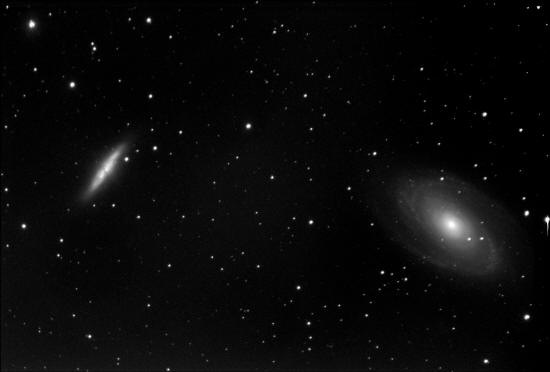For June 2008, the Moon will be new on June 3rd, so the first two weeks find the moon waxing in the evening sky. On June 8th, the waxing
crescent moon will approach of Mars, then passes Saturn on the following evening. The moon is high overhead at first quarter on June 10th. The full moon occurs on
June 18th. This is the Flower, Strawberry, Rose, or ĎHoneyí moon, depending on the culture. Just past full, the moon passes just below Jupiter on June 20th, and will
be waning in the morning sky for the last week of June, reaching third quarter on the 26th.
While the naked eye, dark adapted by several minutes away from any bright lights, is a wonderful instrument to stare up into deep space, far
beyond our own Milky Way, binoculars are better for spotting specific deep sky objects. For a detailed map of northern hemisphere skies, about May 29th visit the
www.skymaps.com website and download the map for June 2008; it will have a more extensive calendar, and list of best objects for the naked eyes, binoculars, and
scopes on the back of the map. Also available as the next month begins is wonderful video exploring the June 2008 sky, featuring many different objects, available
from the Hubble Space Telescope website at: http://hubblesite.org/explore_astronomy/tonights_sky/.

Mars is fading fast as the Earth leaves it behind, but it moves rapidly through Cancer toward Leo this month. It will overtake Saturn at the
end of July. Mars is much closer, so its motion is more notable. Saturn is named for the god of time (Chronos in Greek) because he moves so slowly. Saturnís rings are
closing now, and will vanish edge-on at its 2010 equinox. If the image is steady, look for the split in the two bright rings, the Cassini division, and the fainter
crepe ring closer to the planet than the bright A and B rings. You may also see some belts and zones on the planetís disk. The largest, Titan, will be seen in any
small telescope, but others will need larger scopes to spot.
The winter constellations are being swallowed up in the Sunís glare, but you might spot Sirius low in the SW as June begins. Sirius vanishes
into the Sunís glare by mid-June, and this sets the period as ĎDog Daysí, when Sirius lies lost in the Sunís glare. In reality, Sirius is about 20x more luminous than
our star, but also lies eight light years distant, while our star is eight light minutes away from us.
The brightest star in the NW is Capella, distinctively yellow in color. It is a giant star, almost exactly the same temperature as our Sun,
but about ten times the Sun's diameter and about 100X more luminous. Just south of it are the stellar twins, the Gemini, with Castor closer to Capella, and Pollux
closer to the Little Dog Star, Procyon. By the end of June, all the winter stars, like Sirius, are vanished behind the Sun.
Overhead, the Big Dipper rides high. Good scouts know to take its leading pointers north to Polaris, the famed Pole Star. For us, it sits 30
degrees (our latitude) high in the north, while the rotating earth beneath makes all the other celestial bodies spin around it from east to west. Just west of the
bowl of the Dipper lies the fine pair of colliding galaxies, M-81 and M-82, both visible in binoculars on dark, clear nights; they are shown on the Skymaps.com
charts; Bob Gaskin of the EAAA captured this collision with his 6' refractor telescope.
If you drop south from the bowl of the Big Dipper, Leo the Lion rides high. Saturn lies just east of the bright star Regulus, the heart of the
King of Beasts. Note the Egyptian Sphinx is based on the shape of this Lion in the sky.
Taking the arc in the Dipperís handle, we Ďarcí SE to bright orange Arcturus, the brightest star of Spring. Cooler than our yellow Sun, and
much poorer in heavy elements, some believe its strange motion reveals it to be an invading star from another smaller galaxy, now colliding with the Milky Way in
Sagittarius in the summer sky. Moving almost perpendicular to the plane of our Milky Way, Arcturus was the first star in the sky where its proper motion across the
historic sky was noted, by Edmund Halley. Spike south to Spica, the hot blue star in Virgo, then curve to Corvus the Crow, a four sided grouping. It is above Corvus,
in the arms of Virgo, where our large scopes will show members of the Virgo Supercluster, a swarm of over a thousand galaxies about 50 million light years away from
us.
To the east, Hercules is rising, with the nice globular cluster M-13 marked on your sky map and visible in binocs. Several other good globular
clusters are also shown and listed on the best binoc objects on the map back page.
The brightest star of the northern hemisphere, Vega (from Carl Saganís novel and movie, ĎContactí), rises in the NE as twilight deepens. Twice
as hot as our Sun, it appears blue-white, like most bright stars. But to the south, Antares rises about the same time in Scorpius. It appears reddish (its Greek name
means rival of Ares or Mars to the Latins) because it is half as hot as our yellow Sun; it is bright because it is a bloated red supergiant, big enough to swallow up
our solar system all the way out to Saturnís orbit!